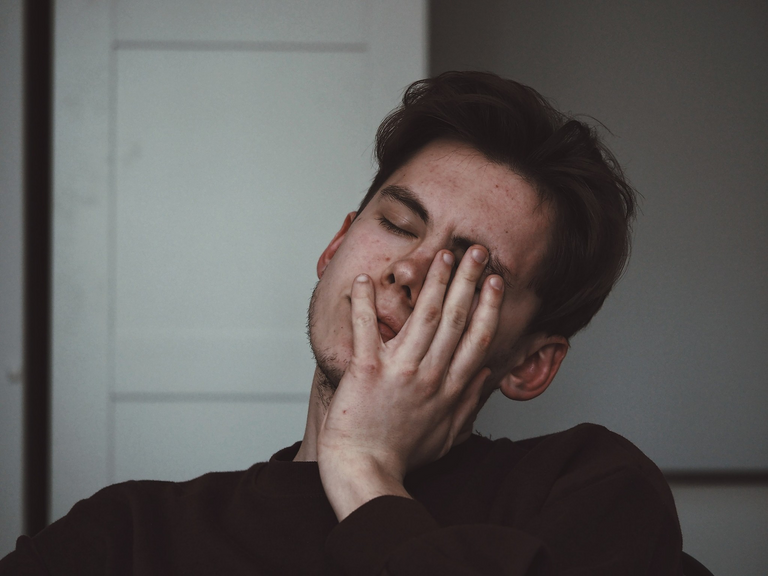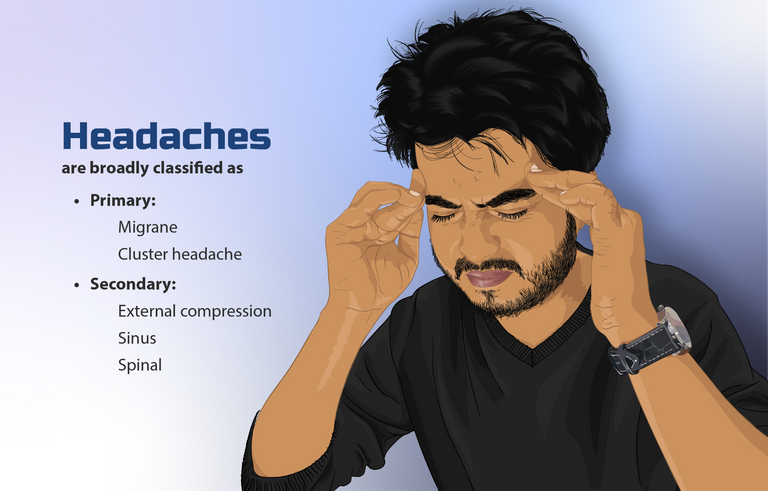
By Phee - Pixabay, CC BY-SA 4.0, Wikimedia
However, there are serious types of Headaches that are usually very troublesome and need urgent medical attention. In this post, I will talk about the various types of headaches and their treatments.
Headache is simply described as a pain that comes from the head or its surrounding strictures. Headaches can be primary or secondary. A primary headache occurs in the absence of any external cause while a secondary headache has an identifiable external cause of the headache. In this post, we will focus more on primary headaches.
TYPES OF PRIMARY HEADACHE
MIGRAINE
Migraine is a very common type of primary headache. It usually occurs in episodes and is associated with nausea, vomiting, and sensitivity to light and sound. In most persons, Migraine occurs on one side of the head, however, they can also occur on both sides.
It starts as a dull headache and later becomes very throbbing and worse with movement. So someone with a Migraine will usually want to isolate him or herself in a very calm and quiet place. This type of headache may be preceded by an aura or warning signs like flashes of light, visual and olfactory hallucinations, etc.
Migraine headache is commoner in women than men and some have a positive family history.
The most important part of a Migraine is that it is associated with a trigger and a good knowledge of these triggers factors will help in preventing the episodes of this headache.
Some of the triggers of migraine headaches include; stress (emotional stress or physical stress), exercise, some foods like alcoholic beverages, cheese, chocolate, or food additives like monosodium glutamate, or missing a meal. Sleep disturbance and irregularities. Drugs, inadequate fluid intake, sensory stimulation like perfumes, the flickering of lights, etc are triggers for migraine headaches.
A bold step in the prevention of migraine episodes lies in the identification and avoidance of these triggers as well as the use of preventive medications.
TREATMENT OF MIGRAINE HEADACHE
The drugs used to treat migraine headaches are in three groups. First to relieve the immediate symptoms, the second group for definitive treatment, and 3rd group for prevention of future episodes.
To relieve immediate symptoms, analgesics are commonly used like Aspirin, paracetamol, ibuprofen, etc, with anti-emetics like metoclopramide.
The drugs used for definitive treatment are triptans and ergot alkaloids while for prevention of future episodes, beta-blockers, 5-HT2 antagonists, and anti-epileptic drugs are commonly used.

By Whole Health JC, CC BY-SA 4.0, Wikimedia
CLUSTER HEADACHE
This type of headache usually has a sudden onset and cessation. It is unilateral and occurs around the eye. It is commoner in males and is associated with increased production of tears, nasal discharge, nasal congestion, nasal stuffiness, watery eyes, sweating, eye swelling, redness, etc. The patient is usually restless and agitated during an attack.
Unlike migraine headaches where the patient chooses to withdraw to a quiet place, someone with cluster headaches is restless and moves around, he may be banging his head due to the intensity of the headache.
TREATMENT OF CLUSTER HEADACHE
The treatment is also in 2 phases, first to manage the acute symptoms and second for prevention.
Drugs sued to manage the immediate symptoms are sumatriptan and lidocaine. While for prevention, prednisolone, ergotamine, verapamil, lithium, etc are commonly used.
TENSION-TYPE HEADACHE
This is the type of headache that mostly occurs following stressful daily activities, tiredness, or lack of sleep. It is often a bilateral and band-like type of headache. It is not associated with other features and is described as a featureless type of headache.
Most persons have experienced a tension-type headache at one point or the other in a lifetime. It does not usually interfere with work, school, or daily activities and may last for hours or even days.
TREATMENT OF TENSION-TYPE HEADACHE
The treatment is by simple analgesics. However, when it occurs more frequently, preventive medications like amitriptyline and imipramine can be used.
SECONDARY HEADACHE
Secondary headaches are headaches with an underlying cause. Such underlying causes may be head trauma, infections, stroke or bleeding vessels in the brain, substance use or withdrawal, hormonal imbalance, systemic diseases, psychiatric problems, etc. Treatment of these types of headaches involves treating the underlying cause.

By Myupchar, CC BY-SA 4.0, Wikimedia
PREVENTION
The prevention of recurrent episodes of primary headaches involves the identification of the trigger factors and avoiding them.
Triggers like stress, lack of sleep, missing meals, sensory stimulation, etc which have been identified as trigger factors for most primary headaches especially migraine headaches should be avoided. Where recurrence of the headache occurs more frequently, prophylactic medications can be very useful.
In summary, headache is one of the commonest symptoms that everyone has experienced at one point or the other in life. In minor cases, the pain subsides after rest or taking simple analgesics.
However, certain types of headaches can be very troublesome and a major cause of school or work absenteeism. It impairs the quality of life and needs medical intervention.
Most of these troublesome headaches have triggers and it is important to identify and avoid the triggers. Certain drugs are also available to prevent recurrent episodes of these headaches.
Thanks for reading through and happy weekend.
For references and further reading;




